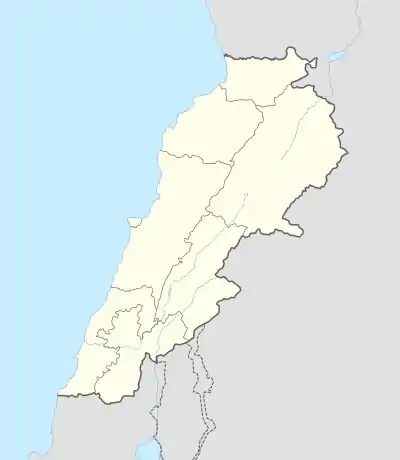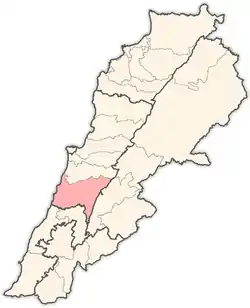Shheem
Shhiim (Arabic: شحيم) alternatively written as Shheem or Chhim/Chhîm is a town in Lebanon which is located 42 kilometres south-east of Beirut. Shhiim is located on 4 mountains in the Chouf region in lebanon. Chhim has a population of about 49,000. It is considered a city by some.
شحيم | |
 Shown within Lebanon | |
| Location | Lebanon |
|---|---|
| Region | Mount Lebanon Governorate, Chouf District |
| Coordinates | 33.6244°N 35.4850°E |
| Type | City, town |
| Part of | Iklim El-Khourroub |
| Area | 8.54 km² |
| Height | 500–900 metres |
| History | |
| Cultures | Roman |
| Associated with | Hamdan, Hajjar, Abdallah, Khatib , Chaaban, Fawaz, Dahrouj, Hajj-Chehade, Younes, Mrad, Daher, Oueidat, Moallem, Saab, El-Halabi, Trawi |
| Site notes | |
| Condition | Developing town |
Shhiim is the largest Sunnite Muslim town in the Chouf region. It is often regarded as the capital of the Iklim el Kharoub which is the coastal part of the Chouf.
Chhim‘s people are known nationally for their role in governmental, army, and police institutions. Chhim is often referred to as the ‘Dawle’ (meaning government) for their high per capita involvement.
Chhim has warm, dry and humid summers, with cold and wet winters. The weather is somewhat similar to that of the coastal cities with a variation of a couple of degrees Celsius.
Politics in Chhim is dominated by the Future Movement and the Progressive Socialist Party, with two MPs from Chhim taking on a role for each respective party.
Shhiim is often confused within size due to many parts of it having different names; some more familiar parts of Shhiim include Marj-Ali, Sahle, Jabal Swed, Chamis and Jirid. These and many others are part of Shhiim but have different names.
Shhiim contains 11 schools, 8 of which are public. It also contains two hospitals, one of them is public, and the other is private.
Features
Shhiim contains many mosques and is mostly inhabited by Sunni Muslims.
It is the site of one of many Temples of the Beqaa Valley.[1][2]
Archaeological site
The archaeological site lies on a slope of a hill on the outskirts of the city. It is a Roman-Byzantine village with a Roman temple towering above the rest of the ancient architecture. The temple faces east and has a small porch. There is a carving of the sun god Helios on one of the doorframes. Another carving portrays the image of a priest with outstretched arms.[2] Haroutune Kalayan reconstructed the temple in the 1970s, and in the 1990s, Renata Ortali Tarazi from the Directorate General of Antiquities of Lebanon (DGA) undertook the task of site preservation. She started a three-way cooperation with the Institut français du Proche-Orient (IFPO), represented by Lévon Nordiguian, and the Polish Centre of Mediterranean Archaeology, University of Warsaw (PCMA UW).[3] An archaeological expedition, established in 1996, worked on the site for more than 20 years under the direction of Tomasz Waliszewski from the PCMA UW.
The settlement was founded at the turn of the eras, although the oldest finds date to the Bronze Age. Parts of the village are remarkably well preserved. Apart from the Roman temple, archaeologists discovered houses clustered along narrow streets, oil presses, and a Christian basilica with mosaics, dated to AD 498. A necropolis surrounded the settlement. The village ceased to function in the 7th century.[4]
Multicolored mosaics covering the whole floor of the basilica are among the most spectacular discoveries made on the site. Most of them depict geometrical patterns, but floral and figural motifs also occur; birds and vessels appear on the surfaces between columns.[5] In the central part of the presbytery, there is a mosaic with a lioness, and in the west aisle, a panel with two antelopes.[6] The iconography of these mosaics bears many similarities to other Byzantine churches in the province of Phoenicia, e.g., in Zahrani and Ghiné.[5] The conservation and protection of the mosaics were carried out by specialists from the Academy of Fine Arts in Warsaw (ASP). The majority of the mosaics from Chhim are currently on display in Lebanese museums.
Footnotes
- Shehadi M. Berbary (1960). The guide to Lebanon. Retrieved 14 November 2012.
- George Taylor (1967). The Roman temples of Lebanon: a pictorial guide. Dar el-Machreq Publishers. Retrieved 1 November 2012.
- Waliszewski T. and Ortali-Tarazi R., 2000 ans d’Historie au cœur d’un village antique du Liban. Catalogue de l'exposition Palais de Beiteddine 7 septembre 2002 - 7 janvier 2003.
- https://pcma.uw.edu.pl/en/2019/04/15/chhim-2/
- Waliszewski, T. and Kowalski, S. P. (1997). Chhim-Jiyeh excavations 1996. Polish Archaeology in the Mediterranean, 8.
- Waliszewski, T. and Wicenciak, U. (2015). Chhim, Lebanon: a Roman and Late Antique village in the Sidon hinterland. Journal of Eastern Mediterranean Archaeology & Heritage Studies, 3(4).
References
- Waliszewski, T. and Wicenciak, U. (2015). Chhim, Lebanon: a Roman and Late Antique village in the Sidon hinterland. Journal of Eastern Mediterranean Archaeology & Heritage Studies, 3(4).
- Waliszewski T. and Ortali-Tarazi R., 2000 ans d’Historie au cœur d’un village antique du Liban. Catalogue de l'exposition Palais de Beiteddine 7 septembre 2002 - 7 janvier 2003.
- Waliszewski, T. and Kowalski, S. P. (1997). Chhim-Jiyeh excavations 1996. Polish Archaeology in the Mediterranean, 8.

